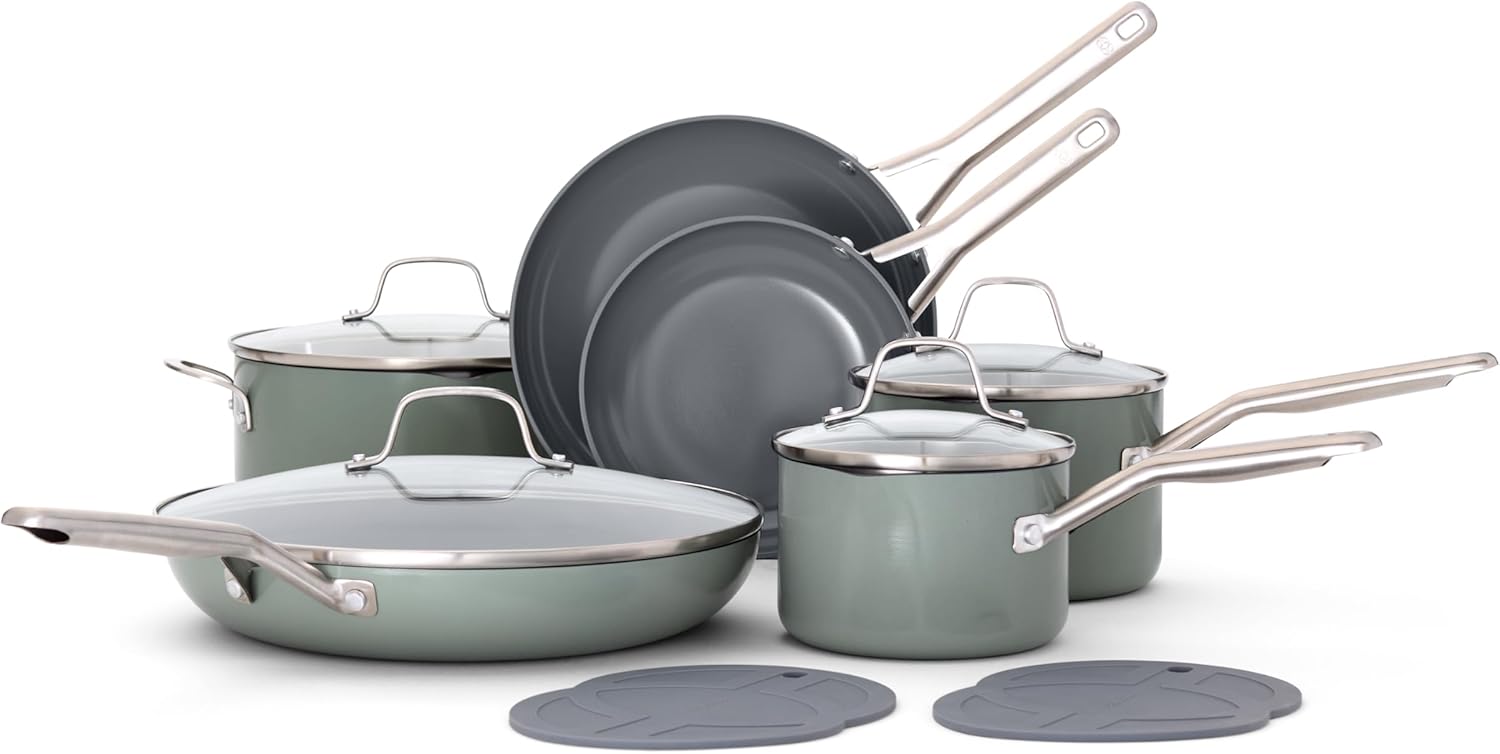





Price: $239.99 - $159.99
(as of Apr 03, 2025 19:57:35 UTC - Details)
Is Ceramic the Best Cookware? An In-Depth Review
Introduction
When it comes to choosing the right cookware for your kitchen, the options can be overwhelming. One material that has gained immense popularity in recent years is ceramic. But the question remains: is ceramic the best cookware? In this article, we will explore the various aspects of ceramic cookware, including its benefits, drawbacks, and comparisons with other materials. By the end, you'll have a clearer understanding of whether ceramic is the right choice for your cooking needs.
What is Ceramic Cookware?
Ceramic cookware is typically made from clay that has been fired at high temperatures. This process creates a non-porous surface that is resistant to staining and easy to clean. Unlike traditional non-stick cookware, ceramic is often free from harmful chemicals like PFOA and PTFE. As we dive deeper into this topic, we will explore specific features of ceramic cookware that contribute to its rising popularity.
Benefits of Ceramic Cookware
1. Non-Toxic and Safe
One of the most compelling reasons to consider ceramic cookware is its safety. Many brands emphasize that their ceramic products are free from harmful chemicals, making them a healthier option for cooking. This is particularly important for those concerned about the potential health risks associated with synthetic non-stick coatings.
2. Excellent Heat Distribution
Ceramic cookware is known for its ability to distribute heat evenly. This means your food will cook more consistently, reducing the chances of hot spots that can lead to uneven cooking. This feature is particularly beneficial for baking, where even heat is crucial for perfect results.
Durability and Longevity
3. Scratch-Resistant Surface
Another significant advantage of ceramic cookware is its scratch-resistant surface. Unlike traditional non-stick pans that can get scratched easily, ceramic surfaces are generally more durable. This allows for the use of metal utensils without the fear of damaging the coating.
4. Stain Resistance
Ceramic cookware's non-porous surface also means that it is resistant to stains. This makes it easier to maintain and keeps your cookware looking new for longer. Whether it’s tomato sauce or greasy dishes, ceramic cookware handles it all without retaining odors or stains.
Drawbacks of Ceramic Cookware
5. Limited Heat Tolerance
While ceramic cookware can handle high temperatures, it is not suitable for every cooking method. Prolonged exposure to extreme heat can lead to cracking or chipping. Therefore, it's essential to use ceramic cookware according to the manufacturer's guidelines to ensure longevity.
6. Weight Considerations
Ceramic cookware tends to be heavier than some alternatives, like aluminum. While this can add to its durability, it might be a drawback for individuals who prefer lightweight cookware for ease of handling.
Comparing Ceramic Cookware with Other Materials
7. Ceramic vs. Non-Stick Cookware
When comparing ceramic to traditional non-stick cookware, one of the main points of contention is safety. While many non-stick pans are coated with chemicals that can emit harmful fumes when overheated, ceramic cookware is generally more environmentally friendly. However, traditional non-stick pans may offer better release properties for certain foods.
8. Ceramic vs. Stainless Steel
Stainless steel cookware is another popular choice among home chefs. While stainless steel is known for its durability and resistance to scratching, it does not offer the same non-stick properties as ceramic. This means that while ceramic may require less oil for cooking, stainless steel can be more challenging for delicate foods.
Cooking Techniques Best Suited for Ceramic Cookware
9. Ideal for Baking
Ceramic cookware excels in baking applications. Its ability to retain heat makes it perfect for casseroles, lasagnas, and other baked dishes. The even heat distribution ensures that your food bakes uniformly, resulting in delicious, perfectly cooked meals.
10. Sautéing and Stir-Frying
While ceramic can be used for sautéing and stir-frying, you should be mindful of the heat settings. Using medium to low heat is advisable to prevent any damage to the cookware. Additionally, adding a little oil can help prevent food from sticking.
Cleaning and Maintenance
11. Easy to Clean
One of the standout features of ceramic cookware is its easy cleanup. Most ceramic pieces are dishwasher safe, making them a convenient option for busy home cooks. However, hand washing with mild soap and a soft sponge is recommended to prolong the life of the cookware.
12. Care Tips for Longevity
To ensure your ceramic cookware lasts, avoid using metal utensils and abrasive cleaners. Instead, opt for silicone or wooden utensils and gentle cleaning solutions. Additionally, avoid extreme temperature changes, as this can lead to cracking.
Conclusion
So, is ceramic the best cookware? While it may not be perfect for every cooking scenario, its non-toxic nature, excellent heat distribution, and easy cleanup make it a strong contender. Whether you are baking or sautéing, ceramic cookware offers unique benefits that can enhance your cooking experience. Ultimately, the best cookware for you will depend on your cooking style and preferences, but ceramic is undoubtedly a worthy option to consider for a healthier kitchen.
Cookware Cleans in Seconds with Quick Cleaning Technology: Nonstick surface keeps foods from sticking so you can spend more time cooking, less time cleaning.
Ceramic Nonstick Coating Made Without PFAS: Cook healthier, without the need for additional oil or butter.
Dishwasher-Safe: Hand washing recommended.
Metal Utensil-Safe: Pots and pans have scratch-resistant interiors.
Stay-Cool Handles: Long stainless steel handles keep cool on stovetops.
Oven-Safe Up to 450 Degrees F: Goes from stovetop to oven with ease, with tempered glass lids that let you monitor food while it's cooking.
Electric, Glass, & Gas Stove Compatible: Versatile nonstick cookware for use in every kitchen.
12-Piece Set Includes: 8" frying pan, 10" frying pan, 12" frying pan with lid, 1.5-qt. sauce pan with lid, 2.5-qt. sauce pan with lid, 5-qt. Dutch oven with lid, and 2 trivets.
Limited 10-Year Warranty
